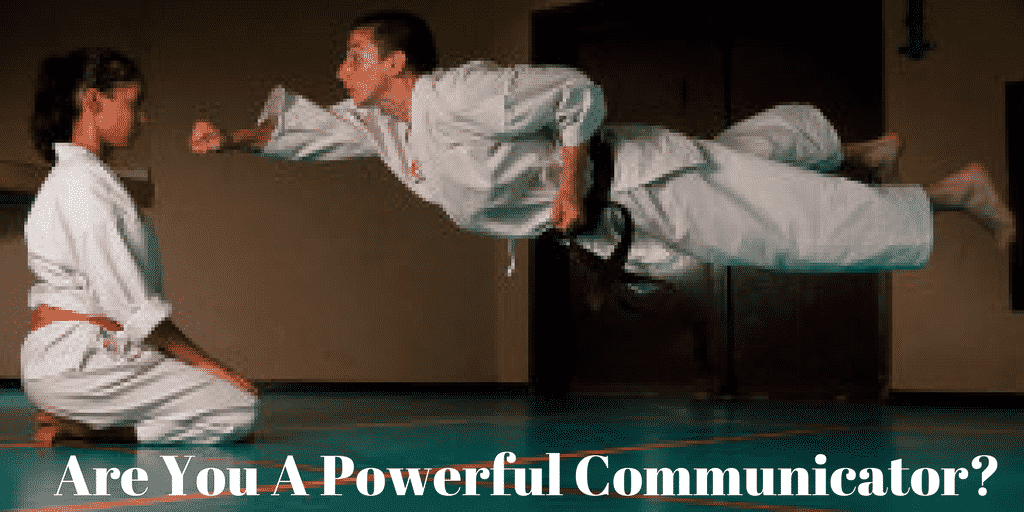Are You A Powerful Communicator?

70% of your communications are non-verbal.
It’s possible you’ve heard this statistic (or some variation of it) but do you know how to interpret it? How to change your non-verbal communications and become a powerful communicator?
I’m always eager to deepen this conversation for myself and my clients, so last week I participated in a small-group training with Wendy Palmer on powerful non-verbal leadership tools. Wendy Palmer, author of Leadership Embodiment, and 6th degree black belt in Akido, has spent much of her career studying the body behaviors and positions that empower leaders and their communications.
Watching Wendy command the group’s attention and flow effortlessly around her dojo was itself, a perfect demonstration in strong leadership. Since I can’t capture that for you, however, I’ve distilled my top three takeaways from my session with Wendy for your benefit.
1) We all have immediate go-to behaviors under stress
 Wendy paired us into groups of two and set up a simple scenario where one person pushes gently, but suddenly, on the wrists of other person facing them. What we could quickly see is that each person had his or her own immediate “reactive” behaviors.
Wendy paired us into groups of two and set up a simple scenario where one person pushes gently, but suddenly, on the wrists of other person facing them. What we could quickly see is that each person had his or her own immediate “reactive” behaviors.
Some people stepped backwards away from the person exerting pressure, while others held their ground. Some people pushed their heads forward (a sign of moving into action under pressure), while others slightly tipped their heads back (signaling that they tend to collect more data before acting under pressure).
Whatever your “default” response behavior was, it doesn’t change – even if you try to take on a different posture. This will always be your immediate “go-to” action under stress. What can change though, is your second response; how quickly can you notice your default behavior and choose your next course of action rather than continuing in default mode?
2) You have more power when you’re mobilizing, not pushing
Wendy next did this amazing exercise, which is hard to believe until you feel it. She had us place our hand on her collar bone and push while she tried to go forward. It was essentially a battle of strength and it felt exhausting with little movement on either side.
I’m sure you’ve had these moments at work where you are dead-locked with a colleague over different ideas and neither one of you seem to be able to move the conversation productively forward without “giving up.”
After centering herself, and mobilizing the imagined energetic strength of those she respected and admired, the dynamic changed. Wendy was able to easily move the other person into walking backwards without a push-pull battle – it was almost as if the energy in her forward motion compelled the other person to walk backwards.
Her teaching was that when we are acting in service of others, we can mobilize some of their energy to help us personally break through a stalemate.
This can be powerful at work.
Personal factions or silos often develop between co-workers with different personalities or different agendas. Wendy’s point was that when you are acting on behalf of others and a shared purpose, you can use that to mobilize a more influential energy that really shifts others. This is much more powerful than when you are pushing an ego-driven personal plan forward.
3) “Unstick” yourself through more powerful postures
Wendy’s over-arching message to leaders is this: change your posture and your body, the change and your leadership ability will follow.
In our western culture, we spend a lot of time and energy trying to “think” better. How can you work harder, more productively? How can you give feedback the “right” way? Even how can you adopt a more positive attitude and outlook?
I’m not saying those things aren’t important and don’t matter. But the point Wendy was driving home was that so much of our influence comes from our body language – yet we spend much more time figuring out how to change our thoughts and our speech.
It’s time for leaders to devote time to building the body of a leader, as well as the mind of a leader, through powerful postures and centering practices.
What about you? Do you pay attention to the powerful non-verbal messages you are sending in the workplace?
If you are looking to develop the mind and body of a leader, comment below!
[…] we focused primarily on the messages your body language is sending during interactions at work. (You can read more about it here) I was moved by the power of this type of powerful communication […]